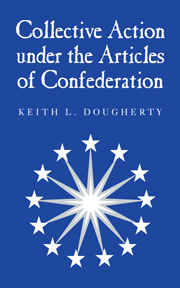Book contents
- Frontmatter
- Contents
- List of Tables and Figures
- Acknowledgments
- 1 The Mystery of State Contribution
- 2 National Interests and State Sovereignty: Objectives of the Confederation
- 3 Collective Action and the Provision of Public Goods
- 4 The History of State Compliance
- 5 State Contributions and Private Interests
- 6 Reacting to Rebellion
- 7 A New Constitution
- 8 Conclusion
- Appendix: Olson's Collective Action Game
- Glossary
- References
- Index
Appendix: Olson's Collective Action Game
Published online by Cambridge University Press: 15 October 2009
- Frontmatter
- Contents
- List of Tables and Figures
- Acknowledgments
- 1 The Mystery of State Contribution
- 2 National Interests and State Sovereignty: Objectives of the Confederation
- 3 Collective Action and the Provision of Public Goods
- 4 The History of State Compliance
- 5 State Contributions and Private Interests
- 6 Reacting to Rebellion
- 7 A New Constitution
- 8 Conclusion
- Appendix: Olson's Collective Action Game
- Glossary
- References
- Index
Summary
A number of simplifications help create a model of continuous, pure public goods. First, assume that states purchased the amount of a public good between zero and infinity that maximized their monetary net benefits. Second, set aside states that opposed the purchase of a good or received negative benefits from its provision. This will help to show that all the states could benefit from a public good but still choose to freeride. Third, assume that states have complete information and each state's payoff function is common knowledge. State 1 knows state 2's payoffs, state 2 knows that 1 knows this, and so on. Complete information simplifies the analysis and makes the model's empirical prediction more precise. Finally, assume that each state has unlimited resources to apply toward the purchase of public goods. Although the final assumption is clearly unrealistic, it helps to show that the free-rider problem is independent of ability to pay. Even with unlimited resources, states still find it rational to withhold their contributions. Combined, these assumptions create a continuous payoff function that reflects the decision to pay in an institution-free setting.
THE PROVISION OF THE PURE PUBLIC GOODS IN AN INSTITUTION-FREE SETTING
More precise formalism helps illustrate the game theoretic prediction for an institution-free setting.
- Type
- Chapter
- Information
- Collective Action under the Articles of Confederation , pp. 183 - 192Publisher: Cambridge University PressPrint publication year: 2000

